Deck 9: The Basics of Experimentation and Testing for a Difference Between Means
Question
Question
Question
Question
Question
Question
Question
Question
Question
Question
Question
Question
Question
Question
Question
Question
Question
Question
Question
Question
Question
Question
Question
Question
Question
Question
Question
Question
Question
Question
Question
Question
Question
Question
Question
Question
Question
Question
Question
Question
Question
Question
Question
Question
Question
Question
Question
Question
Question
Question
Question
Question
Question
Question
Question
Question
Question
Question
Question
Question
Question
Question
Question
Question
Question
Question
Question
Question
Question
Question
Question
Question
Question
Question
Question
Question
Question
Question
Question
Question

Unlock Deck
Sign up to unlock the cards in this deck!
Unlock Deck
Unlock Deck
1/82
Play
Full screen (f)
Deck 9: The Basics of Experimentation and Testing for a Difference Between Means
1
To decide that the independent variable is responsible for the difference between the means of two groups in an experiment, it is necessary to determine the.
A)difference expected from sampling error alone
B)effect expected from the dependent variable
C)variation due to the level of alpha
D)difference due to the independent variable
A)difference expected from sampling error alone
B)effect expected from the dependent variable
C)variation due to the level of alpha
D)difference due to the independent variable
A
2
Sampling error implies that.
A)mistakes always will be made in selecting participants for an experiment
B)the means for samples selected from the same population will differ by some chance amount
C)the means for samples selected from the same population will always be equal
D)we can decide if an independent variable has an effect by visually inspecting the means of the different groups in an experiment
A)mistakes always will be made in selecting participants for an experiment
B)the means for samples selected from the same population will differ by some chance amount
C)the means for samples selected from the same population will always be equal
D)we can decide if an independent variable has an effect by visually inspecting the means of the different groups in an experiment
B
3
Equivalent groups typically are formed by.
A)selecting two or more samples randomly from the population
B)ensuring that the proportions of males and females are the same in each group
C)matching participants for extraneous characteristics
D)randomly assigning participants to groups
A)selecting two or more samples randomly from the population
B)ensuring that the proportions of males and females are the same in each group
C)matching participants for extraneous characteristics
D)randomly assigning participants to groups
D
4
Extraneous variables in an experiment can affect the.
A)size of the population
B)size of the needed sample
C)dependent variable
D)independent variable
A)size of the population
B)size of the needed sample
C)dependent variable
D)independent variable

Unlock Deck
Unlock for access to all 82 flashcards in this deck.
Unlock Deck
k this deck
5
The dilemma facing the experimenter is determining how large a difference between the sample means is enough to decide that something other than is at work in the experiment.
A)the independent variable
B)a treatment effect
C)sampling error
D)systematic variation
A)the independent variable
B)a treatment effect
C)sampling error
D)systematic variation

Unlock Deck
Unlock for access to all 82 flashcards in this deck.
Unlock Deck
k this deck
6
A simulated treatment condition in an experiment is called a(n) control.
A)simulated
B)experimenter
C)confounded
D)placebo
A)simulated
B)experimenter
C)confounded
D)placebo

Unlock Deck
Unlock for access to all 82 flashcards in this deck.
Unlock Deck
k this deck
7
An independent variable must have at least levels.
A)one or more
B)two or more
C)three or more
D)four or more
A)one or more
B)two or more
C)three or more
D)four or more

Unlock Deck
Unlock for access to all 82 flashcards in this deck.
Unlock Deck
k this deck
8
Equivalent groups are expected to.
A)be exactly the same in every way
B)not differ in any systematic way before being given the independent variable
C)represent different populations
D)have bimodal distributions
A)be exactly the same in every way
B)not differ in any systematic way before being given the independent variable
C)represent different populations
D)have bimodal distributions

Unlock Deck
Unlock for access to all 82 flashcards in this deck.
Unlock Deck
k this deck
9
A placebo control group in an experiment would.
A)not be administered the dependent variable
B)receive a simulated treatment condition
C)be randomly selected but not randomly assigned
D)not be considered an equivalent group
A)not be administered the dependent variable
B)receive a simulated treatment condition
C)be randomly selected but not randomly assigned
D)not be considered an equivalent group

Unlock Deck
Unlock for access to all 82 flashcards in this deck.
Unlock Deck
k this deck
10
If two groups are expected to differ only by chance before the independent variable is given, then the groups are considered to be.
A)separate but equal
B)identical
C)equivalent
D)matched
A)separate but equal
B)identical
C)equivalent
D)matched

Unlock Deck
Unlock for access to all 82 flashcards in this deck.
Unlock Deck
k this deck
11
When two or more groups are used in an experiment, the number of subjects in each group is indicated by.
A)N
B)#S
C)nA
D)NS
A)N
B)#S
C)nA
D)NS

Unlock Deck
Unlock for access to all 82 flashcards in this deck.
Unlock Deck
k this deck
12
When two or more groups are used in an experiment, the total number of subjects in the experiment is indicated by.
A)N
B)#S
C)nA
D)NS
A)N
B)#S
C)nA
D)NS

Unlock Deck
Unlock for access to all 82 flashcards in this deck.
Unlock Deck
k this deck
13
In actual experimentation, random sampling rarely is used. Rather, sampling typically is used.
A)stratified
B)clustered
C)occasional
D)convenience
A)stratified
B)clustered
C)occasional
D)convenience

Unlock Deck
Unlock for access to all 82 flashcards in this deck.
Unlock Deck
k this deck
14
Obtaining participants for an experiment by asking people accessible to the experimenter to participate is called sampling
A)simple random
B)valid
C)convenience
D)experimental
A)simple random
B)valid
C)convenience
D)experimental

Unlock Deck
Unlock for access to all 82 flashcards in this deck.
Unlock Deck
k this deck
15
Which of the following occurs first when performing an experiment?
A)Predicting a relationship between an independent variable and a dependent variable.
B)Selecting the level of alpha.
C)Identifying extraneous variables.
D)Forming equivalent groups.
A)Predicting a relationship between an independent variable and a dependent variable.
B)Selecting the level of alpha.
C)Identifying extraneous variables.
D)Forming equivalent groups.

Unlock Deck
Unlock for access to all 82 flashcards in this deck.
Unlock Deck
k this deck
16
Random assignment of participants requires that.
A)every person selected for the experiment has an equal chance of being assigned to any one of the treatment groups
B)the selection of one person to participate in the experiment is independent of the selection of any other person
C)all members of a population have an equal chance of being selected to participate in the experiment
D)all the above
A)every person selected for the experiment has an equal chance of being assigned to any one of the treatment groups
B)the selection of one person to participate in the experiment is independent of the selection of any other person
C)all members of a population have an equal chance of being selected to participate in the experiment
D)all the above

Unlock Deck
Unlock for access to all 82 flashcards in this deck.
Unlock Deck
k this deck
17
Variables other than the independent variable that can affect the dependent variable are called variables.
A)distracter
B)interrupter
C)intervening
D)extraneous
A)distracter
B)interrupter
C)intervening
D)extraneous

Unlock Deck
Unlock for access to all 82 flashcards in this deck.
Unlock Deck
k this deck
18
An experiment in which one independent variable is manipulated and two equivalent groups of subjects are formed is using a design.
A)one-factor within-subjects
B)one-factor between-subjects
C)two-factor within-subjects
D)two-factor between-subjects
A)one-factor within-subjects
B)one-factor between-subjects
C)two-factor within-subjects
D)two-factor between-subjects

Unlock Deck
Unlock for access to all 82 flashcards in this deck.
Unlock Deck
k this deck
19
In an experiment designed to measure the effect of a drug on behavior, one group may be given a medication with no active ingredient; this group is identified as a(n) control group.
A)dependent variable
B)confounded
C)experimental treatment
D)placebo
A)dependent variable
B)confounded
C)experimental treatment
D)placebo

Unlock Deck
Unlock for access to all 82 flashcards in this deck.
Unlock Deck
k this deck
20
An experimenter manipulates the independent variable of the difficulty of a list of words a person is asked to memorize. One group of participants is given an easy list to memorize, the second group of participants is given a difficult list of words to memorize. The levels of this independent variable are.
A)list difficulty
B)the number of participants in each group
C)easy list and difficult list
D)the number of words memorized
A)list difficulty
B)the number of participants in each group
C)easy list and difficult list
D)the number of words memorized

Unlock Deck
Unlock for access to all 82 flashcards in this deck.
Unlock Deck
k this deck
21
In a directional tind test, a rejection region is located in of the sampling distribution of t.
A)the left tail
B)the right tail
C)either the left tail or the right tail, but not both tails
D)both tails
A)the left tail
B)the right tail
C)either the left tail or the right tail, but not both tails
D)both tails

Unlock Deck
Unlock for access to all 82 flashcards in this deck.
Unlock Deck
k this deck
22
The standard error of the difference between means is given by 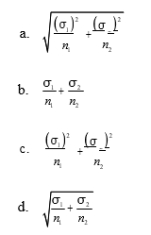


Unlock Deck
Unlock for access to all 82 flashcards in this deck.
Unlock Deck
k this deck
23
The numerator of tind is.
A)a measure of error variation
B)a measure of how much two sample means differ from each other
C)the standard error of the difference between means
D)the sampling distribution of the difference between means
A)a measure of error variation
B)a measure of how much two sample means differ from each other
C)the standard error of the difference between means
D)the sampling distribution of the difference between means

Unlock Deck
Unlock for access to all 82 flashcards in this deck.
Unlock Deck
k this deck
24
The distribution of the difference between two sample means when all possible pairs of samples of size n are selected from a population is called a.
A)standard error of the sampling distribution
B)sampling error distribution
C)t distribution
D)sampling distribution of the difference between means
A)standard error of the sampling distribution
B)sampling error distribution
C)t distribution
D)sampling distribution of the difference between means

Unlock Deck
Unlock for access to all 82 flashcards in this deck.
Unlock Deck
k this deck
25
The null hypothesis for tind is H0:. 


Unlock Deck
Unlock for access to all 82 flashcards in this deck.
Unlock Deck
k this deck
26
The standard error of a theoretical sampling distribution of differences between means is .
A
B)
C)the standard deviation of the distribution of differences between sample means
D)the same as s
A

B)

C)the standard deviation of the distribution of differences between sample means
D)the same as s

Unlock Deck
Unlock for access to all 82 flashcards in this deck.
Unlock Deck
k this deck
27
In a nondirectional tind test, a rejection region is located in of the sampling distribution of t.
A)the center
B)the left tail
C)the right tail
D)both tails
A)the center
B)the left tail
C)the right tail
D)both tails

Unlock Deck
Unlock for access to all 82 flashcards in this deck.
Unlock Deck
k this deck
28
The degrees of freedom for tind are found by.
A)N
B)N - 1
C)N + 2
D)N - 2
A)N
B)N - 1
C)N + 2
D)N - 2

Unlock Deck
Unlock for access to all 82 flashcards in this deck.
Unlock Deck
k this deck
29
The denominator of tind is.
A)the standard error of the difference between means
B)the difference between the population means
C)a measure of how much two sample means differ from each other
D)the sampling distribution of the difference between means
A)the standard error of the difference between means
B)the difference between the population means
C)a measure of how much two sample means differ from each other
D)the sampling distribution of the difference between means

Unlock Deck
Unlock for access to all 82 flashcards in this deck.
Unlock Deck
k this deck
30
In practice, the standard error of the difference between means is estimated by. 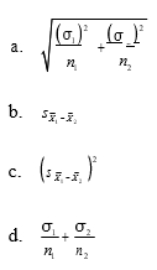


Unlock Deck
Unlock for access to all 82 flashcards in this deck.
Unlock Deck
k this deck
31
For tind, H0. 


Unlock Deck
Unlock for access to all 82 flashcards in this deck.
Unlock Deck
k this deck
32
When rejection regions are located at both ends of the sampling distribution for t, a test is used.
A)two-tailed
B)parametric
C)directional
D)one-tailed
A)two-tailed
B)parametric
C)directional
D)one-tailed

Unlock Deck
Unlock for access to all 82 flashcards in this deck.
Unlock Deck
k this deck
33
The formula for tind is. 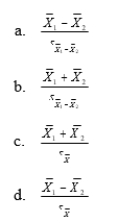


Unlock Deck
Unlock for access to all 82 flashcards in this deck.
Unlock Deck
k this deck
34
If a control group has 20 participants and an experimental group also has 20 participants, then the degrees of freedom for tind on the two groups are.
A)40
B)38
C)20
D)19
A)40
B)38
C)20
D)19

Unlock Deck
Unlock for access to all 82 flashcards in this deck.
Unlock Deck
k this deck
35
The alternative hypothesis for tind is H1:. 
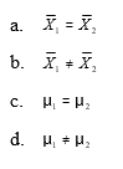



Unlock Deck
Unlock for access to all 82 flashcards in this deck.
Unlock Deck
k this deck
36
If group A1 has 14 participants and group A2 has 12 participants, then tind on the two groups would have degrees of freedom.
A)12
B)14
C)24
D)26
A)12
B)14
C)24
D)26

Unlock Deck
Unlock for access to all 82 flashcards in this deck.
Unlock Deck
k this deck
37
If H0 is rejected when tind falls into either the extreme left or extreme right region of the sampling distribution, then it is called a test.
A)one-tailed
B)two-tailed
C)directional
D)bi-directional
A)one-tailed
B)two-tailed
C)directional
D)bi-directional

Unlock Deck
Unlock for access to all 82 flashcards in this deck.
Unlock Deck
k this deck
38
The sampling distribution of the difference between means.
A)is positively skewed and unimodal
B)approaches a normal distribution as sample size increases
C)is bimodal with the standard error dependent upon sample size
D)is negatively skewed and unimodal
A)is positively skewed and unimodal
B)approaches a normal distribution as sample size increases
C)is bimodal with the standard error dependent upon sample size
D)is negatively skewed and unimodal

Unlock Deck
Unlock for access to all 82 flashcards in this deck.
Unlock Deck
k this deck
39
The tind is appropriate for analyzing data from a one-factor design using levels of an independent variable.
A)within-subjects; two
B)within-subjects; three or more
C)between-subjects; two
D)between-subjects; three or more
A)within-subjects; two
B)within-subjects; three or more
C)between-subjects; two
D)between-subjects; three or more

Unlock Deck
Unlock for access to all 82 flashcards in this deck.
Unlock Deck
k this deck
40
The rejection region for tind represents the values of t that have a probability alpha if .
A)greater than; H0 is true
B)greater than; H1 is false
C)less than or equal to; H0 is true
D)less than or equal to; H1 false
A)greater than; H0 is true
B)greater than; H1 is false
C)less than or equal to; H0 is true
D)less than or equal to; H1 false

Unlock Deck
Unlock for access to all 82 flashcards in this deck.
Unlock Deck
k this deck
41
The power of tind can be increased by.
A)maximizing the effect of the independent variable
B)minimizing the effect of the independent variable
C)increasing the value of s
X1 − X 2
D)decreasing the difference between
A)maximizing the effect of the independent variable
B)minimizing the effect of the independent variable
C)increasing the value of s
X1 − X 2
D)decreasing the difference between

Unlock Deck
Unlock for access to all 82 flashcards in this deck.
Unlock Deck
k this deck
42
If tobs falls into a rejection region, then the decision is to.
A)reject the null hypothesis
B)fail to reject the null hypothesis
C)do not accept the alternative hypothesis
D)increase the value of alpha
A)reject the null hypothesis
B)fail to reject the null hypothesis
C)do not accept the alternative hypothesis
D)increase the value of alpha

Unlock Deck
Unlock for access to all 82 flashcards in this deck.
Unlock Deck
k this deck
43
If tobs does not fall into a rejection region, then the decision is to.
A)reject the null hypothesis
B)fail to reject the null hypothesis
C)accept the alternative hypothesis
D)decrease the value of alpha
A)reject the null hypothesis
B)fail to reject the null hypothesis
C)accept the alternative hypothesis
D)decrease the value of alpha

Unlock Deck
Unlock for access to all 82 flashcards in this deck.
Unlock Deck
k this deck
44
If H0 is not rejected in a tind test, then.
A)H1 is accepted
B)the alpha level should be increased
C)the observed difference between the sample means is attributed to sampling error
D)the distribution of scores in the sample is normal
A)H1 is accepted
B)the alpha level should be increased
C)the observed difference between the sample means is attributed to sampling error
D)the distribution of scores in the sample is normal

Unlock Deck
Unlock for access to all 82 flashcards in this deck.
Unlock Deck
k this deck
45
If tobs falls into a rejection region, then which of the following is true?
A)The probability of obtaining tobs if H0 is true is greater than the alpha level.
B)The alternative hypothesis is not accepted.
C)The null hypothesis is rejected.
D)The null hypothesis is not rejected.
A)The probability of obtaining tobs if H0 is true is greater than the alpha level.
B)The alternative hypothesis is not accepted.
C)The null hypothesis is rejected.
D)The null hypothesis is not rejected.

Unlock Deck
Unlock for access to all 82 flashcards in this deck.
Unlock Deck
k this deck
46
If the results of an experiment using tind were summarized as t(48) = 1.632, p > .05, then you would know that the total number of participants used (N) was and the null hypothesis was.
A)48; rejected
B)48; not rejected
C)50; rejected
D)50; not rejected
A)48; rejected
B)48; not rejected
C)50; rejected
D)50; not rejected

Unlock Deck
Unlock for access to all 82 flashcards in this deck.
Unlock Deck
k this deck
47
Increasing the size of the sample in an experiment will the value of.
A)increase; the standard error of the difference between means
B)decrease; the standard error of the difference between means
C)increase; alpha
D)decrease; alpha
A)increase; the standard error of the difference between means
B)decrease; the standard error of the difference between means
C)increase; alpha
D)decrease; alpha

Unlock Deck
Unlock for access to all 82 flashcards in this deck.
Unlock Deck
k this deck
48
If tobs does not fall into a rejection region, then the.
A)value of alpha should be changed from .05 to .01
B)mean of the sampling distribution of the t statistic is not equal to zero
C)standard error is smaller than the hypothesized difference in population means
D)null hypothesis is not rejected
A)value of alpha should be changed from .05 to .01
B)mean of the sampling distribution of the t statistic is not equal to zero
C)standard error is smaller than the hypothesized difference in population means
D)null hypothesis is not rejected

Unlock Deck
Unlock for access to all 82 flashcards in this deck.
Unlock Deck
k this deck
49
The use of tind rests on the assumption that the.
A)variances of the samples are equal
B)variances of the populations are equal
C)standard errors of the samples are equal
D)standard errors of the populations are equal
A)variances of the samples are equal
B)variances of the populations are equal
C)standard errors of the samples are equal
D)standard errors of the populations are equal

Unlock Deck
Unlock for access to all 82 flashcards in this deck.
Unlock Deck
k this deck
50
A "robust" test implies that violations of the assumptions have little effect on the.
A)distribution of the standard error
B)distribution of the degrees of freedom
C)probability of a Type I error
D)probability of a Type II error
A)distribution of the standard error
B)distribution of the degrees of freedom
C)probability of a Type I error
D)probability of a Type II error

Unlock Deck
Unlock for access to all 82 flashcards in this deck.
Unlock Deck
k this deck
51
Saying that a statistical test is "robust" means that violating an assumption of the test has little effect on the.
A)probability of a Type I error
B)probability of a Type II error
C)obtained value of the standard error of the difference between means
D)sampling distribution of differences between sample means
A)probability of a Type I error
B)probability of a Type II error
C)obtained value of the standard error of the difference between means
D)sampling distribution of differences between sample means

Unlock Deck
Unlock for access to all 82 flashcards in this deck.
Unlock Deck
k this deck
52
The power of tind can be increased by.
A)minimizing the effect of the independent variable
B)increasing the value of s
C)increasing the difference between
D)decreasing the difference between
A)minimizing the effect of the independent variable

B)increasing the value of s
C)increasing the difference between
D)decreasing the difference between

Unlock Deck
Unlock for access to all 82 flashcards in this deck.
Unlock Deck
k this deck
53
The use of tind rests on the assumption that.
A)each subject is randomly selected
B)each subject is randomly assigned to a group
C)the population sizes are equal
D)the population means are equal
A)each subject is randomly selected
B)each subject is randomly assigned to a group
C)the population sizes are equal
D)the population means are equal

Unlock Deck
Unlock for access to all 82 flashcards in this deck.
Unlock Deck
k this deck
54
If tobs does not fall into the rejection region, then which of the following is true?
A)The probability of obtaining tobs if H0 is true is less than .05.
B)The alternative hypothesis is accepted.
C)The null hypothesis is rejected.
D)The null hypothesis is not rejected.
A)The probability of obtaining tobs if H0 is true is less than .05.
B)The alternative hypothesis is accepted.
C)The null hypothesis is rejected.
D)The null hypothesis is not rejected.

Unlock Deck
Unlock for access to all 82 flashcards in this deck.
Unlock Deck
k this deck
55
The power of a statistical test is the probability of rejecting H0 when H0 is and H1 is .
A)true; true
B)true; false
C)false; false
D)false; true
A)true; true
B)true; false
C)false; false
D)false; true

Unlock Deck
Unlock for access to all 82 flashcards in this deck.
Unlock Deck
k this deck
56
If the sample means in an experiment differ significantly using tind, then the.
A)null hypothesis was accepted
B)difference is attributed to chance
C)difference is attributed to the dependent variable
D)difference is attributed to the independent variable
A)null hypothesis was accepted
B)difference is attributed to chance
C)difference is attributed to the dependent variable
D)difference is attributed to the independent variable

Unlock Deck
Unlock for access to all 82 flashcards in this deck.
Unlock Deck
k this deck
57
The denominator of tind is.
A)the difference between the population means
B)the difference between the sample means
C)a measure of the variation in differences between population means
D)a measure of the error variation in an experiment
A)the difference between the population means
B)the difference between the sample means
C)a measure of the variation in differences between population means
D)a measure of the error variation in an experiment

Unlock Deck
Unlock for access to all 82 flashcards in this deck.
Unlock Deck
k this deck
58
If tobs falls into a rejection region, then.
A)the null hypothesis is rejected and the alternative hypothesis accepted
B)the null hypothesis is not rejected and the alternative hypothesis is not accepted
C)a Type II error may have occurred
D)the population means probably do not differ
A)the null hypothesis is rejected and the alternative hypothesis accepted
B)the null hypothesis is not rejected and the alternative hypothesis is not accepted
C)a Type II error may have occurred
D)the population means probably do not differ

Unlock Deck
Unlock for access to all 82 flashcards in this deck.
Unlock Deck
k this deck
59
If the sample means in an experiment differ significantly using tind, then.
A)the null hypothesis was rejected
B)the experiment could not have been confounded
C)the alternative hypothesis was not accepted
D)all the above
A)the null hypothesis was rejected
B)the experiment could not have been confounded
C)the alternative hypothesis was not accepted
D)all the above

Unlock Deck
Unlock for access to all 82 flashcards in this deck.
Unlock Deck
k this deck
60
The power of tind can be increased by.
A)minimizing the effect of the independent variable
B)increasing the value of s
C)decreasing the difference between
D)decreasing the value of
A)minimizing the effect of the independent variable
B)increasing the value of s

C)decreasing the difference between
D)decreasing the value of

Unlock Deck
Unlock for access to all 82 flashcards in this deck.
Unlock Deck
k this deck
61
If knowing the level of an independent variable received by a participant does not at all improve prediction of that participant 's score in an experiment, then will be. 
A)-1.0
B)100 percent
C)1.0
D)0.0

A)-1.0
B)100 percent
C)1.0
D)0.0

Unlock Deck
Unlock for access to all 82 flashcards in this deck.
Unlock Deck
k this deck
62
If the result of a tind on an experiment is reported as t(28) = 2.633, p < .05, then you know that the.
A)critical value of t was 2.633
B)alpha level was less than .05
C)total number of subjects was 28
D)total number of subjects was 30
A)critical value of t was 2.633
B)alpha level was less than .05
C)total number of subjects was 28
D)total number of subjects was 30

Unlock Deck
Unlock for access to all 82 flashcards in this deck.
Unlock Deck
k this deck
63
If the results of an experiment using tind were summarized as t(24) = 1.974, p > .05, then you would know that the probability of the difference between the means occurring by chance is and that the difference is.
A)less than or equal to.05; nonsignificant
B)less than or equal to.05; statistically significant
C)greater than .05; nonsignificant
D)greater than .05; statistically significant
A)less than or equal to.05; nonsignificant
B)less than or equal to.05; statistically significant
C)greater than .05; nonsignificant
D)greater than .05; statistically significant

Unlock Deck
Unlock for access to all 82 flashcards in this deck.
Unlock Deck
k this deck
64
In a within-subjects design,.
A)all groups of subjects receive different levels of each independent variable
B)a single group of subjects is given each level of the independent variable
C)all groups of subjects receive the same levels of each independent variable
D)all subjects are matched for attributes on extraneous variables
A)all groups of subjects receive different levels of each independent variable
B)a single group of subjects is given each level of the independent variable
C)all groups of subjects receive the same levels of each independent variable
D)all subjects are matched for attributes on extraneous variables

Unlock Deck
Unlock for access to all 82 flashcards in this deck.
Unlock Deck
k this deck
65
If knowing the level of an independent variable received by a participant allows perfect prediction of that participant 's score in an experiment, then will be. 
A)100
B)100 percent
C)1.0
D)either -1.0 or +1.0

A)100
B)100 percent
C)1.0
D)either -1.0 or +1.0

Unlock Deck
Unlock for access to all 82 flashcards in this deck.
Unlock Deck
k this deck
66
If the results of an experiment using tind were summarized as t(20) = 2.146, p < .05, then you would know that the probability of the difference between the means occurring by chance is and that the difference is.
A)less than or equal to.05; nonsignificant
B)less than or equal to.05; statistically significant
C)greater than .05; nonsignificant
D)greater than .05; statistically significant
A)less than or equal to.05; nonsignificant
B)less than or equal to.05; statistically significant
C)greater than .05; nonsignificant
D)greater than .05; statistically significant

Unlock Deck
Unlock for access to all 82 flashcards in this deck.
Unlock Deck
k this deck
67
A journal report of the results of a tind on two groups in an experiment should include which of the following?
A)The sample size.
B)The mean and a measure of variability for each group.
C) ∗
∗
D)All the above.
A)The sample size.
B)The mean and a measure of variability for each group.
C)
 ∗
∗D)All the above.

Unlock Deck
Unlock for access to all 82 flashcards in this deck.
Unlock Deck
k this deck
68
Increasing the sample size in an experiment will.
A)decrease the standard error of the difference between means
B)increase the standard error of the difference between means
C)increase the difference between
D)decrease the difference between
A)decrease the standard error of the difference between means
B)increase the standard error of the difference between means
C)increase the difference between
D)decrease the difference between

Unlock Deck
Unlock for access to all 82 flashcards in this deck.
Unlock Deck
k this deck
69
Eta squared represents the proportion of total variation in scores that is accounted for by .
A)the independent variable
B)the dependent variable
C)error variation
D)variation within treatment groups
A)the independent variable
B)the dependent variable
C)error variation
D)variation within treatment groups

Unlock Deck
Unlock for access to all 82 flashcards in this deck.
Unlock Deck
k this deck
70
For tind, is obtained by. 
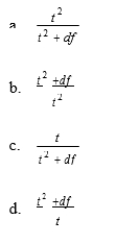



Unlock Deck
Unlock for access to all 82 flashcards in this deck.
Unlock Deck
k this deck
71
If the results of an experiment using tind were summarized as t(30) = 2.817, p < .05, then you would know that the total number of participants used (N) was and the null hypothesis was.
A)32; rejected
B)32; not rejected
C)30; rejected
D)30; not rejected
A)32; rejected
B)32; not rejected
C)30; rejected
D)30; not rejected

Unlock Deck
Unlock for access to all 82 flashcards in this deck.
Unlock Deck
k this deck
72
Eta squared is a measure of the.
A)power of a statistical test
B)strength of association
C)amount of error variation within groups
D)probability of making correct decisions about the statistical null and alternative hypotheses
A)power of a statistical test
B)strength of association
C)amount of error variation within groups
D)probability of making correct decisions about the statistical null and alternative hypotheses

Unlock Deck
Unlock for access to all 82 flashcards in this deck.
Unlock Deck
k this deck
73
Extensive variation in the measure of the dependent variable in an experiment will.
A)increase the probability of a Type I error
B)increase the power of a statistical test
C)decrease the power of a statistical test
D)enable the use of a smaller sample
A)increase the probability of a Type I error
B)increase the power of a statistical test
C)decrease the power of a statistical test
D)enable the use of a smaller sample

Unlock Deck
Unlock for access to all 82 flashcards in this deck.
Unlock Deck
k this deck
74
The value of may range from.
A)0.0 to 100.0
B)0.0 to 1.0
C)-1.0 to +1.0
D)-10.0 to +10.0
A)0.0 to 100.0

B)0.0 to 1.0
C)-1.0 to +1.0
D)-10.0 to +10.0

Unlock Deck
Unlock for access to all 82 flashcards in this deck.
Unlock Deck
k this deck
75
Extensive error variation within the groups of an experiment will.
A)increase the probability of a Type I error
B)result in a more detectable treatment effect
C)increase the power of a statistical test
D)decrease the power of a statistical test
A)increase the probability of a Type I error
B)result in a more detectable treatment effect
C)increase the power of a statistical test
D)decrease the power of a statistical test

Unlock Deck
Unlock for access to all 82 flashcards in this deck.
Unlock Deck
k this deck
76
Eta squared provides a measure of.
A)error variation
B)the value of the difference between population means
C)the minimum sample size required to achieve a specific level of power
D)the strength of effect of an independent variable
A)error variation
B)the value of the difference between population means
C)the minimum sample size required to achieve a specific level of power
D)the strength of effect of an independent variable

Unlock Deck
Unlock for access to all 82 flashcards in this deck.
Unlock Deck
k this deck
77
Rejecting H0 with a tind and a two-tailed test.
A)does not necessarily provide support for a research hypothesis in an experiment
B)provides direct support for a research hypothesis in an experiment
C)can only occur if α equals .01
D)is always a Type II error
A)does not necessarily provide support for a research hypothesis in an experiment
B)provides direct support for a research hypothesis in an experiment
C)can only occur if α equals .01
D)is always a Type II error

Unlock Deck
Unlock for access to all 82 flashcards in this deck.
Unlock Deck
k this deck
78
Which of the following is a criticism of statistical hypothesis testing?
A)The probability of a Type I error cannot be precisely specified.
B)The probability of a Type II error cannot be precisely specified.
C)Null hypotheses are almost always true.
D)Humans are better intuitive judges of statistical significance than are statistical tests.
A)The probability of a Type I error cannot be precisely specified.
B)The probability of a Type II error cannot be precisely specified.
C)Null hypotheses are almost always true.
D)Humans are better intuitive judges of statistical significance than are statistical tests.

Unlock Deck
Unlock for access to all 82 flashcards in this deck.
Unlock Deck
k this deck
79
The 95 percent confidence interval for the difference between two independent population means is given by. 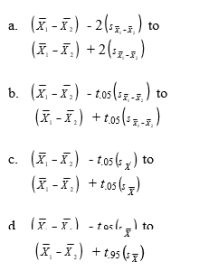


Unlock Deck
Unlock for access to all 82 flashcards in this deck.
Unlock Deck
k this deck
80
If the result of a tind on an experiment is reported as t(28) = 2.633, p < .05, then you know that the.
A)critical value of t was 2.633
B)alpha level was less than .05
C)observed value of t was 2.633
D)total number of subjects was 28
A)critical value of t was 2.633
B)alpha level was less than .05
C)observed value of t was 2.633
D)total number of subjects was 28

Unlock Deck
Unlock for access to all 82 flashcards in this deck.
Unlock Deck
k this deck



